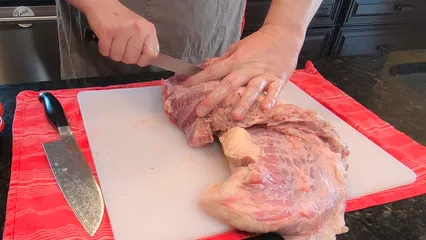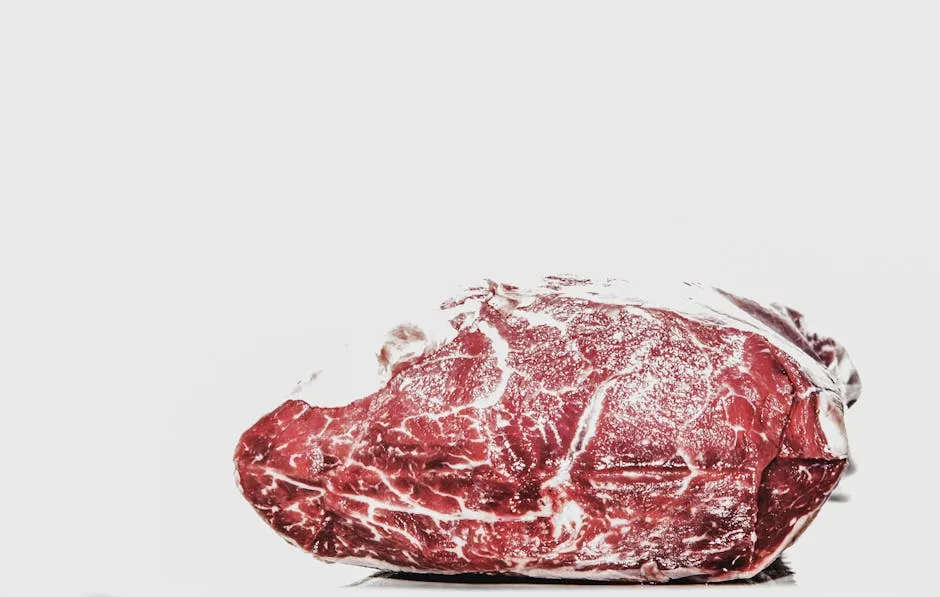Introduction
Raw meat safety is crucial for preventing foodborne illnesses. Improper handling and cooking can lead to serious health risks. Key themes include handling, storage, cooking, and preventing contamination.
Summary and Overview
Understanding raw meat safety helps protect your health. Many foodborne illnesses stem from consuming raw meat. Common pathogens include Salmonella and E. coli. Safe practices in shopping, preparation, and cooking are vital. We will cover these topics in detail.
Understanding Raw Meat Safety
Raw meat safety focuses on preventing illness from harmful pathogens. Statistics show that millions fall ill annually due to foodborne illnesses. The CDC estimates 48 million cases each year, leading to thousands of hospitalizations.
Salmonella, E. coli, and Campylobacter are common pathogens found in raw meat. These bacteria can cause severe health issues, especially in vulnerable populations. Food safety guidelines emphasize proper handling and cooking to mitigate these risks.
It’s essential to recognize that foodborne illnesses can occur from cross-contamination and improper cooking. By understanding raw meat safety, you can significantly reduce your chances of getting sick. For more insights on specific pathogens, continue reading!

How to Select Safe Raw Meat
Selecting fresh, safe raw meat starts at the grocery store. Always check expiration dates and inspect packaging for damage. Meat should appear bright and have a pleasant odor.
Signs of spoilage vary by type. For beef, avoid dark or slimy cuts. Poultry should not be faded or sticky. Fresh fish must be firm and smell clean. If the packaging is torn or leaking, don’t buy it.
Using a checklist while grocery shopping can help ensure you select quality meat. This simple practice can save you from potential health risks. Always prioritize meat quality for your safety!
To make your meat selection process easier, consider investing in a Kitchen Scale. This handy tool helps you measure your meat accurately, ensuring you get just the right amount for your recipes!

Proper Handling Techniques
Handling raw meat safely is crucial for preventing foodborne illnesses. It all starts with hygiene. Always wash your hands with soap and warm water before and after handling any raw meat. This simple step can significantly reduce the risk of spreading harmful bacteria.
Using separate utensils and cutting boards for raw meat is essential. Designate specific cutting boards for meat and others for fruits or vegetables. This practice helps avoid cross-contamination, which occurs when harmful bacteria from raw meat transfer to other foods. It’s a good idea to color-code your cutting boards. For instance, use red for meats and green for vegetables.
Cross-contamination prevention is vital. After handling raw meat, thoroughly clean all surfaces and utensils. Use hot, soapy water to wash cutting boards, knives, and countertops. If you marinate meat, do so in a sealed container. Never reuse marinades unless they’ve been boiled first.
To make meal prep even more efficient, invest in a Cutting Board Set. With multiple boards, you can easily assign one for meat and another for veggies, keeping your kitchen safe and organized!

Safe Storage of Raw Meat
Storing raw meat properly is just as important as handling it safely. Make sure your refrigerator is set to 40°F or below. Raw meat should be stored at the bottom of the fridge to prevent any juices from contaminating other foods. This simple step can help avoid unwanted bacteria spreading to ready-to-eat items.
When it comes to freezing, wrap raw meat tightly in leak-proof packaging. This prevents freezer burn and keeps the meat safe from harmful microbes. Be mindful of storage times; different meats have varying shelf lives. For instance, uncooked poultry should be consumed within 1-2 days, while steaks can last 3-4 days in the fridge.
Always check your freezer’s temperature, ideally around 0°F. If in doubt about how long to keep raw meat, refer to meat storage guidelines. You can also create a downloadable guide for quick reference on meat storage times. Keeping track of these details helps maintain food safety and quality.
For detailed information on how to store raw meat safely, check out this raw diet freezer storage guide.

Cooking Raw Meat Safely
Cooking raw meat to the correct internal temperatures is vital for safety. This ensures that any harmful bacteria are eliminated. Use a meat thermometer to check doneness. For poultry, reach an internal temperature of 165°F. Ground meats should be cooked to 160°F, while whole cuts of beef, pork, and lamb need at least 145°F.
Different types of meat have unique cooking requirements. For example, poultry must always be cooked through, while whole cuts of beef can be served at a lower temperature if the outside is seared. Always check the thickest part of the meat with your thermometer to ensure accurate readings.
Avoid cross-contamination after cooking. Never place cooked meat on the same plate that held raw meat. It’s crucial to use clean utensils when serving cooked food. By adhering to these cooking practices, you significantly reduce the risk of foodborne illnesses. Investing in a Instant Read Meat Thermometer is a smart step to ensure your meals are both delicious and safe.

Myths and Facts About Raw Meat
Many people have misconceptions about handling raw meat. One common myth is that washing raw meat makes it safer. In reality, washing can spread bacteria around your kitchen. The USDA advises against washing meat. Instead, cooking meat to the right temperature ensures safety.
Another myth is that all raw meat is safe to eat if it looks fine. This isn’t true. Consuming raw or undercooked meat poses risks. Pathogens like Salmonella and E. coli can cause severe illness. Cooking meat properly eliminates these harmful bacteria.
Raw meat myths can lead to serious health issues. Always rely on safe cooking practices and temperature guidelines. For instance, poultry should reach an internal temperature of 165°F. Ground meats need to be cooked to at least 160°F.
Understanding these facts helps keep your meals safe. What myths have you heard about raw meat? Share your thoughts in the comments!

Special Considerations for Vulnerable Populations
Certain groups face higher risks from raw meat. Children, pregnant women, and those with weakened immune systems must be extra cautious. For them, the consequences of foodborne illnesses can be severe.
Pregnant women are particularly susceptible to Listeria, which can harm both mother and baby. Children’s immune systems aren’t fully developed, making them vulnerable to infections. Immunocompromised individuals should avoid raw or undercooked meats altogether.
To protect these vulnerable populations, it’s best to stick to well-cooked meats. Always follow food safety advice tailored to these groups. For more information, consider visiting health resources dedicated to food safety.

Cleaning and Sanitizing After Handling Raw Meat
After handling raw meat, cleaning is essential to prevent harmful bacteria from spreading. Bacteria can linger on surfaces, utensils, and even your hands. This can lead to cross-contamination and foodborne illnesses, so let’s prioritize kitchen sanitation.
Start by washing your hands thoroughly with soap and warm water. Scrub for at least 20 seconds, especially under your nails and between your fingers. Next, clean all surfaces that came into contact with raw meat. Use hot, soapy water on cutting boards, countertops, and utensils.
For extra protection, consider using a Food Safe Sanitizer. Solutions containing bleach or other sanitizers can effectively kill bacteria on surfaces. Just make sure to follow the instructions on the label for safe use.
Don’t forget to wash your dishcloths and sponges regularly. These can harbor bacteria if not cleaned often. A good rule of thumb is to replace sponges weekly.
To help you remember these steps, we’ve created a handy checklist for cleaning after meal prep. This guide will make kitchen sanitation easier and help keep your family safe.
Remember, a clean kitchen is a safe kitchen!

Conclusion
Raw meat safety is vital for preventing foodborne illnesses. We’ve discussed the importance of proper handling, storage, cooking techniques, and cleaning practices. By implementing these safe practices in your kitchen, you can significantly reduce the risk of contamination.
Take action today! Share your experiences or tips about raw meat safety in the comments. Your insights could help others stay safe in the kitchen. Together, we can create a community focused on food safety actions.

FAQs
What are the main risks of consuming raw meat?
Consuming raw meat poses significant health risks. The most common danger is foodborne illness. This can occur when raw meat is contaminated with harmful bacteria. Key pathogens include Salmonella, E. coli, and Listeria. These bacteria can cause severe gastrointestinal issues. Symptoms may include nausea, vomiting, and diarrhea. In serious cases, foodborne illnesses can lead to hospitalization or even death. Always cook meat thoroughly to eliminate these risks.
How should raw meat be stored in the refrigerator?
Proper storage of raw meat is essential for safety. Always keep raw meat in the refrigerator at 40°F or below. Store it on the bottom shelf to prevent juices from dripping onto other foods. Use leak-proof containers to catch any spills. Avoid leaving raw meat out at room temperature. If not using within a couple of days, freeze it. Be mindful of storage times; different meats have varying shelf lives.
Is it safe to wash raw meat before cooking?
Washing raw meat is not safe. Many people believe it helps remove bacteria, but it can actually spread germs. When you wash meat, water can splash onto surfaces, contaminating them. The USDA recommends cooking meat to the appropriate temperature instead. This kills any harmful bacteria present. So, skip the wash and focus on proper cooking techniques for safety.
What are the safe cooking temperatures for different types of meat?
Cooking meat to the right temperature is crucial for safety. Here’s a quick reference: Poultry: 165°F, Ground meats (beef, pork, lamb): 160°F, Whole cuts of beef, pork, lamb: 145°F (with a 3-minute rest), Fish: 145°F. Always use a meat thermometer to ensure accuracy.
How can I prevent cross-contamination when handling raw meat?
Preventing cross-contamination is vital for food safety. Here are effective strategies: Use separate cutting boards: one for raw meat, another for vegetables. Wash hands before and after handling raw meat. Keep raw meat stored away from ready-to-eat foods. Clean all surfaces and utensils with hot, soapy water after use. Avoid reusing marinades unless boiled first. By following these steps, you can significantly reduce contamination risks.
What should I do if I suspect I’ve consumed contaminated meat?
If you suspect you’ve eaten contaminated meat, monitor for symptoms. Common signs of foodborne illness include nausea, vomiting, and diarrhea. These symptoms usually appear within 24 hours. If symptoms become severe or last longer than a few days, seek medical attention. It’s important to inform your healthcare provider about potential exposure to contaminated food.
Are there any specific guidelines for freezing raw meat?
Freezing raw meat properly helps maintain safety and quality. Wrap it tightly in leak-proof packaging to prevent freezer burn. Label packages with the date to track storage time. Keep your freezer at 0°F or below. Most raw meats can be stored in the freezer for several months. For best taste and texture, use them within recommended timeframes. Always thaw meat in the refrigerator, never at room temperature.
For those who love to barbecue, consider adding a Barbecue Tool Set to your collection. It’s perfect for grilling enthusiasts who want to elevate their outdoor cooking game!
Please let us know what you think about our content by leaving a comment down below!
Thank you for reading till here 🙂
All images from Pexels





